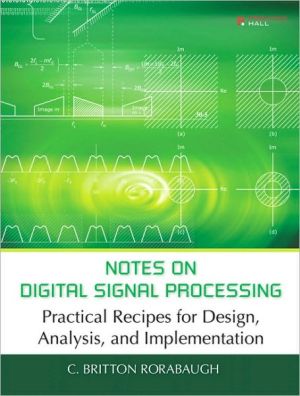

 |

|

Sold Out
Book Categories |
Preface xi
About the Author xiii
Part I: DSP Fundamentals
Note 1: Navigating the DSP Landscape 1-1
Note 2: Overview of Sampling Techniques 2-1
Note 3: Ideal Sampling 3-1
Note 4: Practical Application of Ideal Sampling 4-1
Note 5: Delta Functions and the Sampling Theorem 5-1
Note 6: Natural Sampling 6-1
Note 7: Instantaneous Sampling 7-1
Note 8: Reconstructing Physical Signals 8-1
Part II: Fourier Analysis
Note 9: Overview of Fourier Analysis 9-1
Note 10: Fourier Series 10-1
Note 11: Fourier Transform 11-1
Note 12: Discrete-Time Fourier Transform 12-1
Note 13: Discrete Fourier Transform 13-1
Note 14: Analyzing Signal Truncation 14-1
Note 15: Exploring DFT Leakage 15-1
Note 16: Exploring DFT Resolution 16-1
Part III: Fast Fourier Transform Techniques
Note 17: FFT: Decimation-in-Time Algorithms 17-1
Note 18 FFT: Decimation-in-Frequency Algorithms 18-1
Note 19: FFT: Prime Factor Algorithm 19-1
Note 20: Fast Convolution Using the FFT 20-1
Part IV: Window Techniques
Note 21: Using Window Functions: Some Fundamental Concepts 21-1
Note 22: Assessing Window Functions: Sinusoidal Analysis Techniques 22-1
Note 23: Window Characteristics 23-1
Note 24: Window Choices 24-1
Note 25: Kaiser Windows 25-1
Part V: Classical Spectrum Analysis
Note 26: Unmodified Periodogram 26-1
Note 27: Exploring Periodogram Performance: Sinusoids in Additive White Gaussian Noise 27-1
Note 28: Exploring Periodogram Performance: Modulated Communications Signals 28-1
Note 29: Modified Periodogram 29-1
Note 30: Bartlett’s Periodogram 30-1
Note 31: Welch’s Periodogram 31-1
Part VI: FIR Filter Design
Note 32: Designing FIR Filters: Background and Options 32-1
Note 33: Linear-Phase FIR Filters 33-1
Note 34: Periodicities in Linear-Phase FIR Responses 34-1
Note 35: Designing FIR Filters: Basic Window Method 35-1
Note 36: Designing FIR Filters: Kaiser Window Method 36-1
Note 37: Designing FIR Filters: Parks-McClellan Algorithm 37-1
Part V: Analog Prototype Filters
Note 38: Laplace Transform 38-1
Note 39: Characterizing Analog Filters 39-1
Note 40: Butterworth 40-1
Note 41: Chebyshev Filters 41-1
Note 42: Elliptic Filters 42-1
Note 43: Bessel Filters 43-1
Part VI: z-Transform Analysis
Note 44: The z Transform 44-1
Note 45: Computing the Inverse z Transform Using the Partial Fraction Expansion 45-1
Note 46: Inverse z Transform via Partial Fraction Expansion
Case 1: All Poles Distinct with M < N in System Function 46-1
Note 47: Inverse z Transform via Partial Fraction Expansion
Case 2: All Poles Distinct with M ≥ N in System Function (Explicit Approach) 47-1
Note 48: Inverse z Transform via Partial Fraction Expansion
Case 3: All Poles Distinct with M ≥ N in System Function (Implicit Approach) 48-1
Part VII: IIR Filter Design
Note 49: Designing IIR Filters: Background and Options 49-1
Note 50: Designing IIR Filters: Impulse Invariance Method 50-1
Note 51: Designing IIR Filters: Bilinear Transformation 51-1
Part VIII: Multirate Signal Processing
Note 52: Decimation: The Fundamentals 52-1
Note 53: Multistage Decimators 53-1
Note 54: Polyphase Decimators 54-1
Note 55: Interpolation Fundamentals 55-1
Note 56: Multistage Interpolation 56-1
Note 57: Polyphase Interpolators 57-1
Part IX: Bandpass and Quadrature Techniques
Note 58: Sampling Bandpass Signals 58-1
Note 59: Bandpass Sampling: Wedge Diagrams 59-1
Note 60: Complex and Analytic Signals 60-1
Note 61: Generating Analytic Signals with FIR Hilbert Transformers 61-1
Note 62: Generating Analytic Signals with Frequency-Shifted FIR Lowpass Filters 62-1
Note 63: IIR Phase-Splitting Networks for Generating Analytic Signals 63-1
Note 64: Generating Analytic Signals with Complex Equiripple FIR Filters 64-1
Note 65: Generating I and Q Channels Digitally: Rader’s Approach 65-1
Note 66: Generating I and Q Channels Digitally: Generalization of Rader’s Approach 66-1
Part X: Statistical Signal Processing
Note 67: Parametric Modeling of Discrete-Time Signals 67-1
Note 68: Autoregressive Signal Models 68-1
Note 69: Fitting AR Models to Stochastic Signals: Yule-Walker Method 69-1
Note 70: Fitting All-Pole Models to Deterministic Signals: Autocorrelation Method 70-1
Note 71: Fitting All-Pole Models to Deterministic Signals: Covariance Method 71-1
Note 72: Autoregressive Processes and Linear Prediction Analysis 72-1
Note 73: Estimating Coefficients for Autoregressive Models: Burg Algorithm 73-1
Index I-1
Login|Complaints|Blog|Games|Digital Media|Souls|Obituary|Contact Us|FAQ
CAN'T FIND WHAT YOU'RE LOOKING FOR? CLICK HERE!!! X
 You must be logged in to add to WishlistX
 This item is in your Wish ListX
 This item is in your CollectionNotes on Digital Signal Processing: Practical Recipes for Design, Analysis, and Implementation
X
 This Item is in Your InventoryNotes on Digital Signal Processing: Practical Recipes for Design, Analysis, and Implementation
X
 You must be logged in to review the productsX
 X
 X

Add Notes on Digital Signal Processing: Practical Recipes for Design, Analysis, and Implementation, The Most Complete, Modern, and Useful Collection of DSP Recipes: More Than 50 Practical Solutions and More than 30 Summaries of Pertinent Mathematical Concepts for Working Engineers Notes on Digital Signal Processing is a comprehensive, easy-to-use col, Notes on Digital Signal Processing: Practical Recipes for Design, Analysis, and Implementation to the inventory that you are selling on WonderClubX
 X

Add Notes on Digital Signal Processing: Practical Recipes for Design, Analysis, and Implementation, The Most Complete, Modern, and Useful Collection of DSP Recipes: More Than 50 Practical Solutions and More than 30 Summaries of Pertinent Mathematical Concepts for Working Engineers Notes on Digital Signal Processing is a comprehensive, easy-to-use col, Notes on Digital Signal Processing: Practical Recipes for Design, Analysis, and Implementation to your collection on WonderClub |